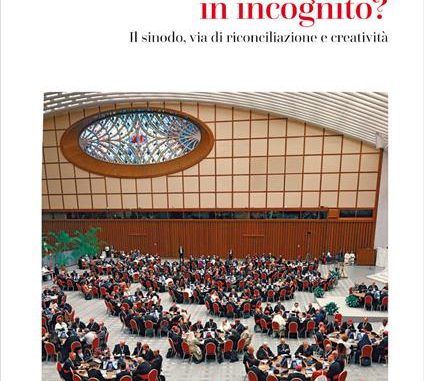
LIBRO IN EVIDENZA-Rubrica periodica di «Catechetica ed Educazione»
Christoph Theobald, Un consiglio in incognito? Il sinodo, cammino di riconciliazione e creatività, EDB, Bologna 2024, pp. 192.
Christoph Theobald, An incognito council? The Synod, a path of reconciliation and creativity, EDB, Bologna 2024, pp. 192.
The Author is a well-known theologian of German origin, resident in Paris, professor at the Centre Sèvres, the Jesuit institute in the French capital. It may be useful to know that many of his works, including this one, have been translated into Italian, in particular by the EDB (publisher of the Dehonians) of Bologna.
Theobald is recognized for his thinking on ecumenical dialogue and for an innovative vision of the role of the Catholic Church in the contemporary world. He affirms, deepens and spreads the need for a “synodal” and fraternal Church, in line with the reforms promoted by Pope Francis.
The book we present is easy to read and understand, written in a calm style, well documented on the reality of the Synod in progress, without that sense of hypercriticism that synodal work is often criticized for and even more ignored.
We note well that the Author does not want to express personal thoughts, but to report and interpret the synodal journey so far. It includes two stages: the result, from the beginning of the work (2021-2022), is summarized in the first Synod (October 2023); a second stage follows that concludes in the second Synod (October 2024). Teobaldo obviously cannot talk about this, since his text was written first, but he foresees the tasks in light of the documents published by the Pope and the General Secretariat. Significant conclusions and new proposals for the continuation of the synodal journey are to be expected.
The vision of the A. is already expressed in the title: An incognito council? The synod, a path of reconciliation and creativity. For Theobald, the current synod is not the deadline of a commitment among many synods, usual in the history of the Church. First of all, it has a close, or rather rooted, connection with the Second Vatican Council, of which it wants to be an extension, not only aspiring to be understood as a council not declared as such (incognito), but to be one in fact, in particular with two of its distinctive traits defined as “path of reconciliation and creativity”, for which the current synod is defined by him as a path, made of openness and dialogue at a religious and social level, with a profoundly innovative, creative purpose, in view of a new evangelization under the guidance of the Spirit of Jesus (or Holy Spirit) that does not make a new Church, but the same Church renewed as in the origins, “not a different Church, but a different Church”.
Theobald’s book fits into this framework of ideas. It is 190 pages well structured in six chapters of which we give here, in brief summary, the contents. The essential inspiration comes from Scripture as a “missionary travel report” that wants to continue in the Synod and is its soul (chap. 1); the. the question is asked: “if synodality is a “constitutive dimension of the Church”, how is it constituted?”. The answer is clear and dominant: it is based on Baptism which creates a fraternal equality of the baptized; it draws its orientation and inspiration from Vatican II; for which the Church must always be understood as “people of God” (chap. 2); a clarification on the Synod itself follows: it is an intercontinental and intercultural journey (some experiences in Africa and Europe are reported, seen as “gifts” of the Holy Spirit) (chap. 3); a solid reflection on the soul of the synodal journey could not be missing: “A journey of spiritual and institutional conversion” (chap. 4); in chaps. 5 and 6 the strong points of the first synodal stage are summarized (until October 2024). The central task remains that which commits the Church to profoundly reform itself. Chap. 5 mentions its contents and fundamental problems: the renewed and indispensable participation of women in the life of the Church; the real involvement of all Christians and not only the clergy; a newfound credibility especially in the face of scandals and institutional crises, underlining the importance of a structural and spiritual reform to regain the trust of the faithful; to this end the Church must renew its way of exercising authority, transforming it into an “authority of fraternity”, capable of promoting dialogue and inclusion; the Church must overcome internal and social conflicts through a spirit of fraternity, thus contributing to cohesion in secularized societies. Last but not least, theological science must give its contribution to the elaboration of emerging thoughts and proposals. In chapter 6, Theobald expresses, so to speak, his synodal dream with a statement that he repeats elsewhere: “synodality must be seen within a messianic vision of the world”.
I conclude by asking whether the breadth, novelty and depth of the synod can be outlined as “a council incognito?”. It is a question that, reading the book, sounds like a challenge: to whom and how can you say no?
Cesare Bissoli
Istituto di Catechetica, UPS. Roma










